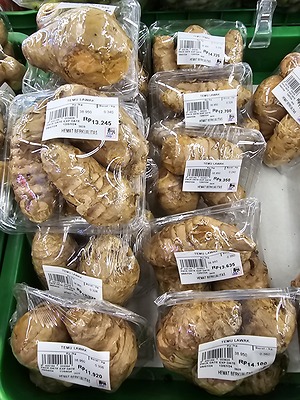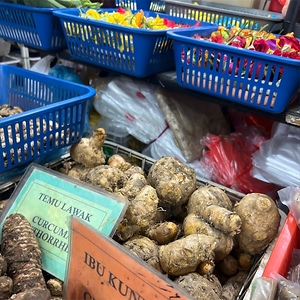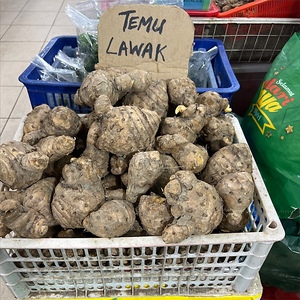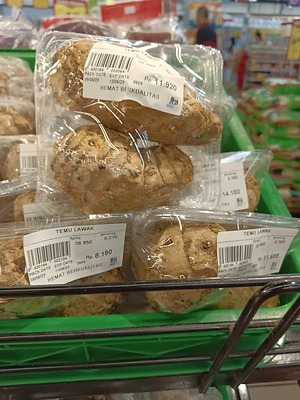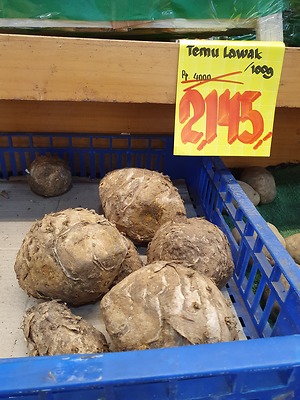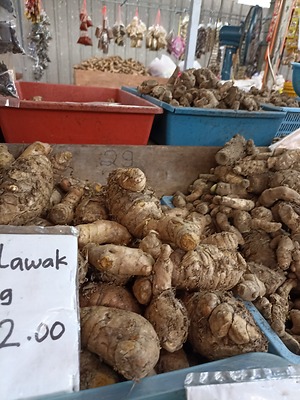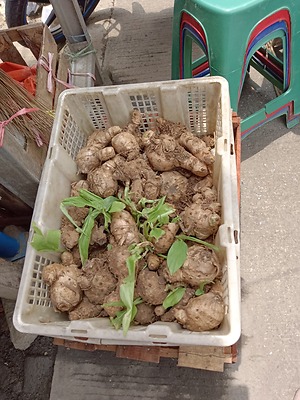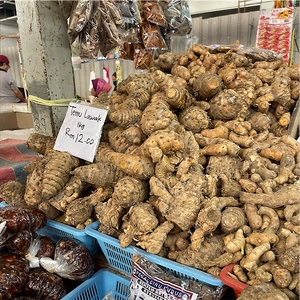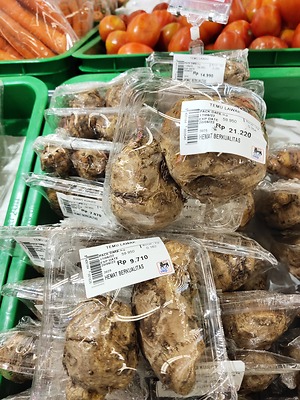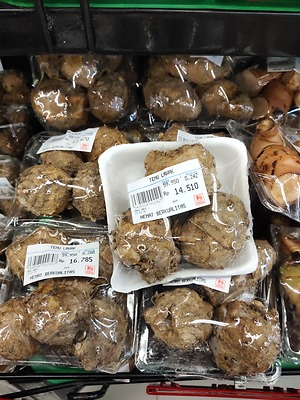

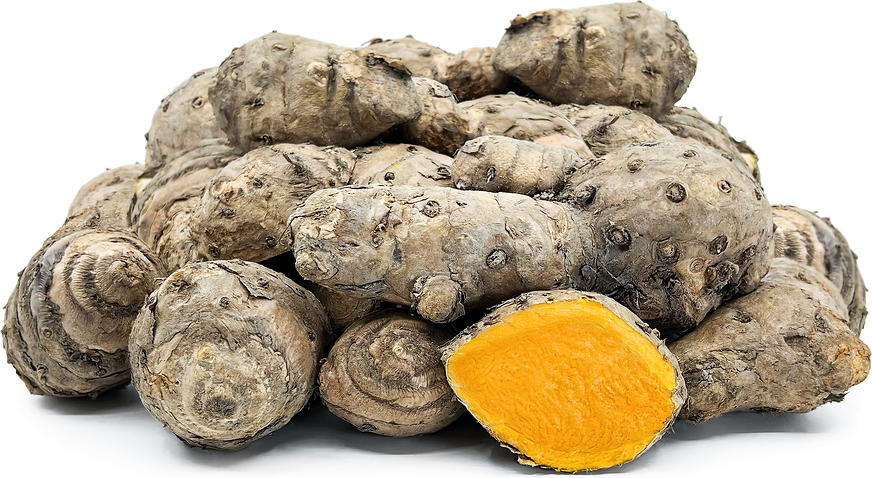
Temulawak Turmeric
Estimated Inventory, lb : 0
Description/Taste
Temulawak rhizomes are a larger species of turmeric, averaging 5 to 7 centimeters in diameter and 8 to 10 centimeters in length, and have a bulbous and oval to slightly elongated appearance with curved edges. The plump rhizomes are covered in tough, textured, and flaky brown skin with many crevices, nodes, and bumps. The surface also showcases faint dark brown to black grooves and rings. Underneath the skin, the flesh is dense, firm, and crisp with a fibrous consistency. The flesh also bears a light orange to golden hue, traditionally softer in color than common commercial turmeric. Temulawak releases a mild and fresh aroma with spice, wood, and earth notes. The flesh has a pungent, bitter, and subtly sweet taste with mildly spicy, nose-tingling properties.
Seasons/Availability
Temulawak is available year-round.
Current Facts
Temulawak, botanically classified as Curcuma xanthorrhiza, is a species of turmeric belonging to the Zingiberaceae family. The underground rhizomes grow in clusters below a leafy pseudostem that reaches 2 to 2.5 meters in height, and the species is native to Indonesia, where it has been used medicinally for thousands of years. Temulawak is also known as Javanese turmeric and Javanese ginger and has acquired several regional names throughout Indonesia, including Tommo in Bali, Karbanga in Ternate, Tommon in South Sulawesi, Koneng Gede in western Java, and Temu Labak in Madura. Temulawak is a medicinal turmeric extensively used in Indonesia for its anti-inflammatory and anti-bacterial properties. The slightly bitter-tasting rhizome is one of the rarer types of turmeric as it is seldom used in cooking and is mainly reserved for natural medicines, but Temulawak is slowly increasing in popularity throughout Southeast Asia as consumers gravitate toward plant-based medicines.
Nutritional Value
Temulawak is a source of potassium to balance fluid levels within the body, fiber to regulate the digestive tract, calcium to build strong bones and teeth, iron to develop the protein hemoglobin for oxygen transport through the bloodstream, and other nutrients such as manganese and vitamin C. The rhizomes also contain curcumin, a compound that contributes anti-inflammatory and antioxidant-like properties to protect the cells in the body from free radical damage. Curcumin is also believed to be a digestive aid. Along with vitamins and minerals, Temulawak is said to contain over forty natural compounds that promote healing within the body.
Applications
Temulawak rhizomes are rarely used for cooking and are mostly incorporated into teas, pressed juices, water infusions, and powders. Despite their medicinal focus, some consumers use rhizomes in raw and cooked preparations such as boiling, stir-frying, or sauteing. When young, fresh Temulawak can be blended into smoothies, juices, or cooked as an aromatic in meat and vegetable dishes. The rhizome can also be dried for extended use, ground into starch for puddings, porridges, yogurt, custard, and gum, or sliced and stir-fried. Beyond using rhizomes in preparations similar to common turmeric, Temulawak is sometimes eaten with fattier foods such as butterfish or eel to increase digestion and promote nutrient absorption. Temulawak pairs well with meats such as poultry, beef, and pork, seafood, cucumbers, aromatics including shallots, garlic, lemongrass, and lime leaves. Whole, uncut Temulawak will keep around one month when stored in a paper or plastic bag in the refrigerator's crisper drawer.
Ethnic/Cultural Info
Temulawak is revered as a medicinal ingredient in Indonesia, traditionally incorporated into jamu, a custom tonic. The practice of creating curated jamu blends in Indonesia can be traced back throughout history for thousands of years, and the herbal tonic combines roots, fruits, and leaves to make a nutritious drink. Jamus containing the juice of pressed Temulawak are used to reduce symptoms associated with nausea, indigestion, and fevers and increase appetite. Temulawak tonics are also often combined with other turmeric varieties and ginger to enhance their anti-inflammatory properties and are mixed with palm sugar to create a more palatable flavor. Custom jamu blends are sold throughout Indonesia in local pharmacy stores, street vendors, and medicinal shops, but home remedies are also passed down through familial generations to treat common ailments.
Geography/History
Temulawak is native to Indonesia, specifically the island of Java, and has been growing wild since ancient times. The rhizomes thrive in warm, tropical climates and were later spread to neighboring countries in Southeast Asia via trade and migration. Temulawak was also introduced into East Asia for its medicinal properties. In 1963, Temulawak was exported to Europe as natural medicine. Today Temulawak is commercially cultivated on the major islands throughout Indonesia, including Maluku, Sumatra, Java, Sulawesi, and Kalimantan. The rhizome is also grown in Malaysia, Thailand, Vietnam, and the Philippines, sold through local markets and is exported to Korea, China, Japan, Europe, and the United States. The rhizomes in the photograph above were sourced from Geylang Serai Market, a well-known Indonesian and Malaysian wet market in Singapore.
Recipe Ideas
Recipes that include Temulawak Turmeric. One
| What To Cook Today |
|
Indonesian Jamu Kunyit Jahe Asam (Turmeric Ginger Tamarind Juice) |



